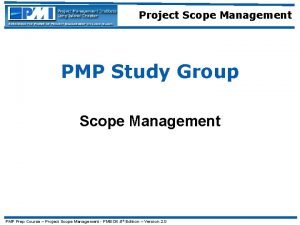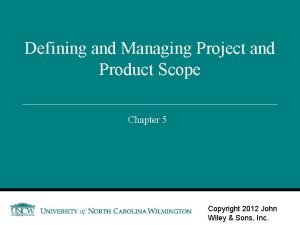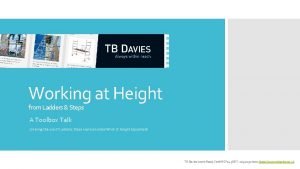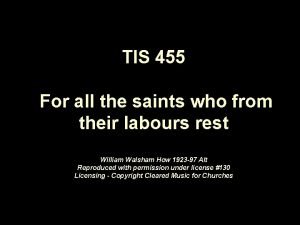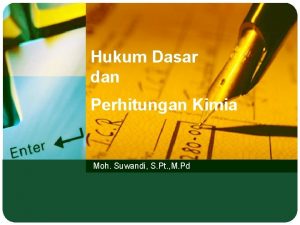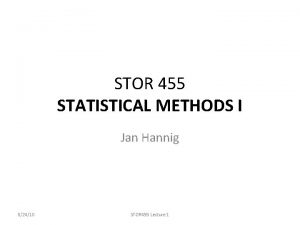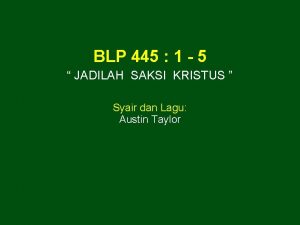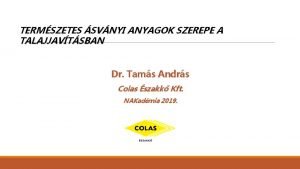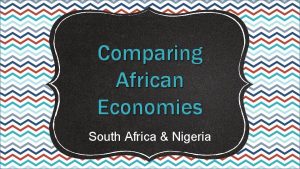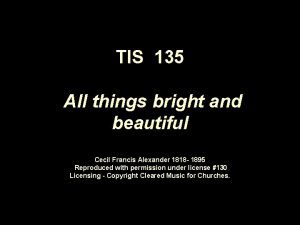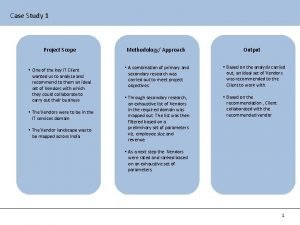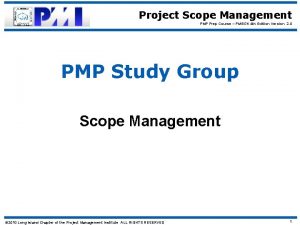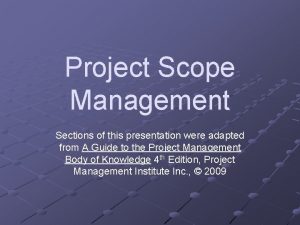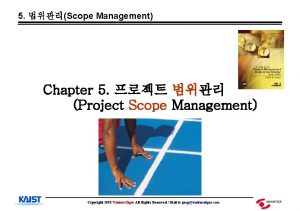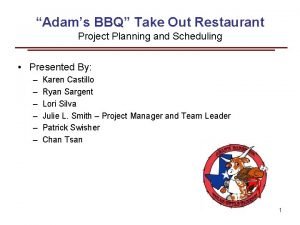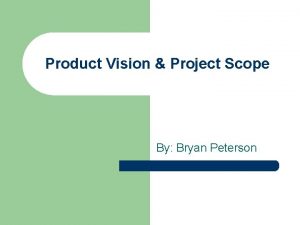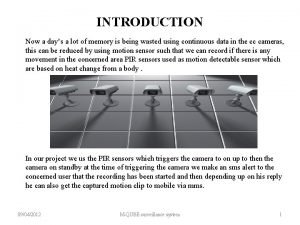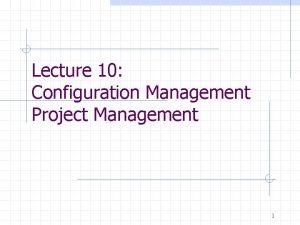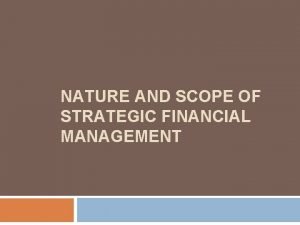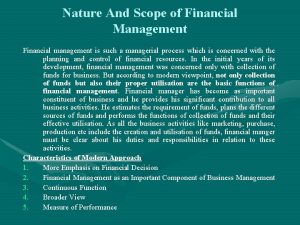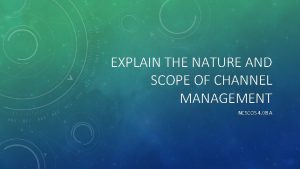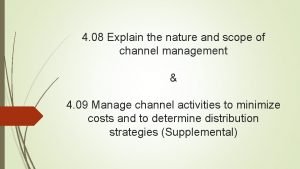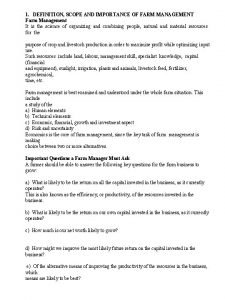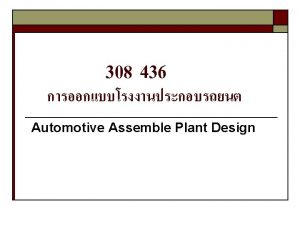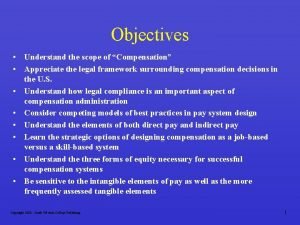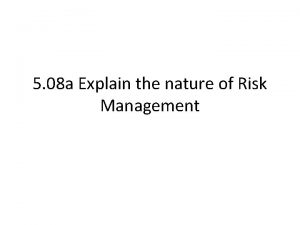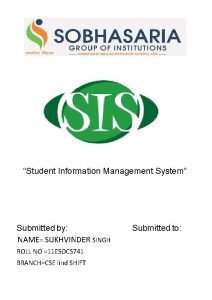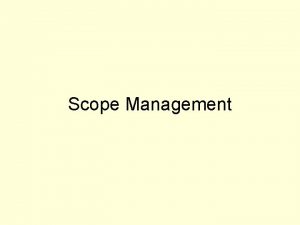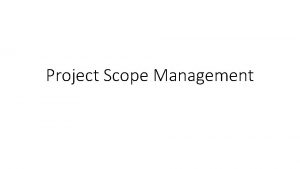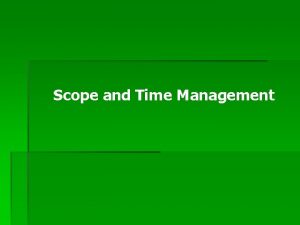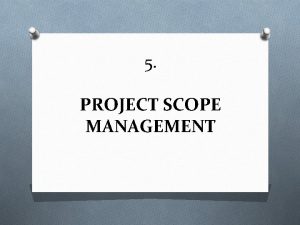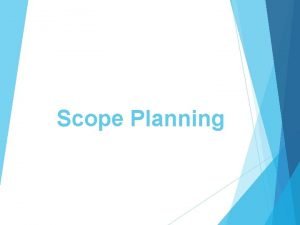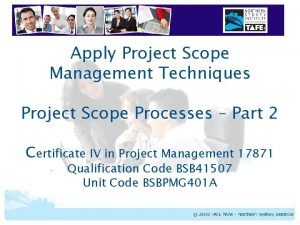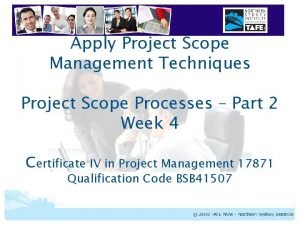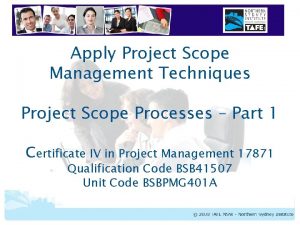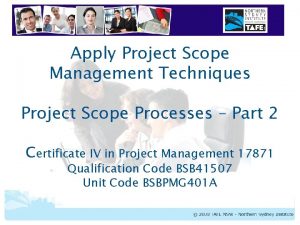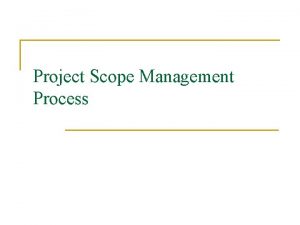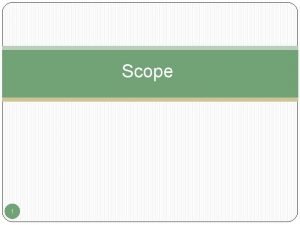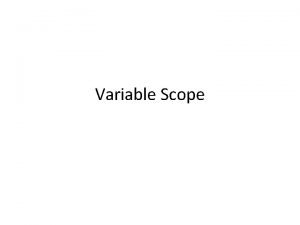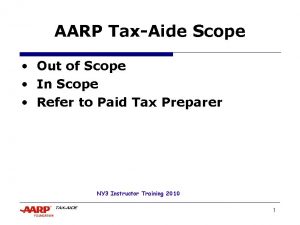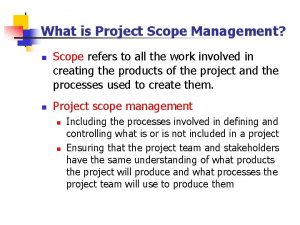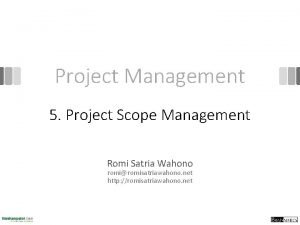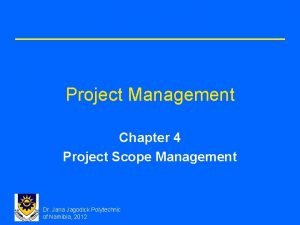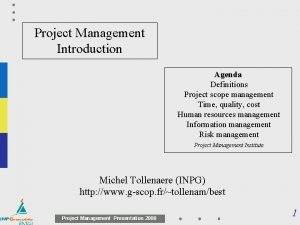IS 455 Project Management How to Scope a




















































- Slides: 52

IS 455 Project Management – How to Scope a TPM Project

Agenda: • Simulation Powered Learning • • Introduction Tips Mentor Program Turn in status reports • • Team Time Tuesday US Bank Speaker Thursday • • This weeks Questions • How to Scope a TPM Project • Weather or not. com (class exercise) next week COPYRIGHT TOM SULZER © 2020 2

How do you balance customer wants vs. needs? Today’s Question(s) What is scope? How to I determine scope of a project? What goes into a Project Scoping meeting? What is the definition of a requirement? What are the different ways to gather requirements? What are the different types of requirements? How does the completeness of requirements effect which PMLC to use? COPYRIGHT TOM SULZER © 2020 3

Simulation Powered Learning Tip #3: It takes time (2 weeks simulation time) to bring a resource onto your project. Plan ahead. Note, releasing a resource can be done immediately. COPYRIGHT TOM SULZER © 2020 4

Simulation Powered Learning Tip #4: You need to leave the “Staff” phase on the schedule when you add resources. Just having the task number is not sufficient for the resource to start working. COPYRIGHT TOM SULZER © 2020 5

Effective Project Management: Traditional, Agile, Extreme Managing Complexity in the Face of Uncertainty Ch 04: How to Scope a TPM Project Presented by Tom Sulzer Copyright Tom Sulzer © 2020 6

Ch 04: How to Scope a TPM Project Summary of Chapter 4 Ø Ø Ø Ø Using tools, templates, and processes to scope a TPM project Managing client expectations Project scoping process Project scoping meeting & deliverables Requirements breakdown structure (RBS) Project classification Choosing the best-fit PMLC Model Project Overview Statement Copyright Tom Sulzer © 2020 7

Ch 04: How to Scope a TPM Project Tools, Templates, & Processes Used to Scope a Project n n n n n Conditions of Satisfaction Project Scoping Meeting Requirements Elicitation Brainstorming Facilitated Group Sessions Interviews Prototyping Requirements Workshops Project Overview Statement Approval to Plan the Project Copyright Tom Sulzer © 2020 8

Ch 04: How to Scope a TPM Project Client Wants vs. Client Needs Dilemma NEEDS WANTS What your client wants may not be what your client needs. Your job is to make sure that what they want is what they need and that you will deliver what they need. Copyright Tom Sulzer © 2020 9

Ch 04: How to Scope a TPM Project Tips to Managing Client Expectations During Scoping n n n n Make sure you understand what your client wants/needs/expects Make sure the client understands what you will do Assure yourself that what your client wants is what your client needs Actively include your client in scoping the project Put yourself in the shoes of your client Meaningfully involve your client wherever possible Keep your client informed of project status Copyright Tom Sulzer © 2020 10

Ch 04: How to Scope a TPM Project Scoping Process Figure 04 -01 Copyright Tom Sulzer © 2020 11

Ch 04: How to Scope a TPM Project Establishing Conditions of Satisfaction Clarify Request Response Request Agree on Response Negotiate agreement and write Project Overview Statement Copyright Tom Sulzer © 2020 Figure 04 -02 12

Ch 04: How to Scope a TPM Project Planning and Conducting the Project Scoping Meeting n Purpose n Document requirements n Project Overview Statement n Attendees n Project Manager n Client Group n Core Team Members n The Facilitator & Technographer Copyright Tom Sulzer © 2020 13

Ch 04: How to Scope a TPM Project Planning and Conducting the Project Scoping Meeting n Agenda n n n Introductions Purpose of the Meeting (led by Facilitator) COS (conduct or review if done earlier) Description of current state (led by client representative) Description of problem or business opportunity (led by client representative) Description of end state (led by client representative) Requirements definition and documentation (led by facilitator) Discussion of the gap between current and end state (led by project manager) Choose best fit project management approach to close the gap (led by project manager) Draft and approve the POS (whole scope planning group) 14 Copyright Tom Sulzer © 2020 Adjourn

Ch 04: How to Scope a TPM Project Planning and Conducting the Project Scoping Meeting n Deliverables n n n RBS creation Assessment of completeness of RBS Project classification Determination of best-fit PMLC Model The POS Copyright Tom Sulzer © 2020 15

Ch 04: How to Scope a TPM Project What Are Requirements? A requirement is something the product/project should do/produce or a quality that it must have. Copyright Tom Sulzer © 2020 16

Ch 04: How to Scope a TPM Project Requirement – A Business Value Perspective Requirement A requirement is a desired end-state whose successful integration into the solution meets one or more needs and delivers specific, measurable, and incremental business value to the organization. Furthermore, the set of high-level requirements forms a necessary and sufficient set for the attainment of incremental business value. Copyright Tom Sulzer © 2020 17

Ch 04: How to Scope a TPM Project Building the Requirements Breakdown Structure NOTE: Ø Requirements #1 through #n form a necessary & sufficient set for attaining expected business value Ø Not all levels are required. Figure 04 -03 Copyright Tom Sulzer © 2020 18

Ch 04: How to Scope a TPM Project Building the Requirements Breakdown Structure Project goal and solution Requirement 1 Function 1. 2 Sub-function 1. 2. 1 Sub-function 1. 2. 2 Feature 1. 2. 1. 1 1. 2 Feature 1. 2. 1. 3 Requirement n Function n. 1 Function 1. 3 Function n. 2 Function n. 3 Sub-function 1. 2. 3 Feature 1. 2. 1. 4 Feature n. 3. 1 Feature n. 3. 3 n. 3. 2 Copyright Tom Sulzer © 2020 Feature n. 3. 4 19

Ch 04: How to Scope a TPM Project Stakeholder Interaction in Requirements Copyright Tom Sulzer © 2020 Figure 04 -04 20

Ch 04: How to Scope a TPM Project Approaches to Requirements Gathering n n n Brainstorming Facilitated Group Sessions Interviews Prototyping Requirements Workshop NOTE: These approaches can be used for decomposition too: § The RBS is most meaningful to the client § The RBS is deliverables-based § The RBS is consistent with the PMBOK § The RBS is client-facing § The RBS is the higher order part of the WBS Copyright Tom Sulzer © 2020 21

Ch 04: How to Scope a TPM Project Brainstorming Strengths 1. 2. 3. Reduces social inhibitions Stimulates idea generation Increases overall creativity of the group Risks 1. 2. 3. Can be dominated by a strong individual Individual fear of being criticized Evaluation of ideas Copyright Tom Sulzer © 2020 22

Ch 04: How to Scope a TPM Project Facilitated Group Session Method Strengths 1. 2. 3. Excellent for cross-functional processes Detailed requirements are documented and verified immediately Resolves issues with an impartial facilitator Risks 1. 2. Untrained facilitators can lead to negative responses Time and cost of planning and executing can be high Table 04 -01 Copyright Tom Sulzer © 2020 23

Ch 04: How to Scope a TPM Project Interview Method Strengths 1. 2. End-user participation High-level description of functions and processes provided Risks 1. 2. 3. Descriptions may differ from actual detailed activities Without structure, stakeholders may not know what information to provide Real needs ignored if analyst is prejudiced Table 04 -01 Copyright Tom Sulzer © 2020 24

Ch 04: How to Scope a TPM Project Prototyping Strengths 1. 2. 3. 4. 5. 6. Innovative ideas can be generated Users clarify what they want Users identify requirements that may be missed Client–focused Early proof of concept Stimulates thought process Risks 1. 2. 3. 4. Client may want to implement prototype Difficult to know when to stop Specialized skills required Absence of documentation Copyright Tom Sulzer © 2020 Table 04 -01 25

Ch 04: How to Scope a TPM Project Requirements Workshop Strengths 1. Good way for first-time use Risks 1. May overwhelm customer Table 04 -01 Copyright Tom Sulzer © 2020 26

Ch 04: How to Scope a TPM Project Categories of Requirements n n Functional Non-functional Global Product/project constraints Copyright Tom Sulzer © 2020 27

Ch 04: How to Scope a TPM Project Definition: Functional Requirement Functional requirements specify what the product or service must do. Give an example of a functional requirement. Copyright Tom Sulzer © 2020 28

Ch 04: How to Scope a TPM Project Definition: Non-Functional Requirement Non-functional requirements demonstrate properties that the product or service should have in order to do what must be done. Give an example of a non-functional requirement. Copyright Tom Sulzer © 2020 29

Ch 04: How to Scope a TPM Project Definition: Global Requirement Global requirements describe the highest level of requirements within the system or product. They can be thought of as general requirements. Give an example of a global requirement. Copyright Tom Sulzer © 2020 30

Ch 04: How to Scope a TPM Project Definition: Product/Project Constraints Product/project constraints are those requirements that, on the surface, resemble design constraints or project constraints. Give an example of a product/project constraint. Copyright Tom Sulzer © 2020 31

Ch 04: How to Scope a TPM Project RBS – The Reality Project goal and solution Requirement 1 Function 1. 2 Sub-function 1. 2. 1 Sub-function 1. 2. 2 Feature 1. 2. 1. 1 1. 2 Feature 1. 2. 1. 3 Requirement n Function 1. 3 Function n. 1 Functional Requireme Function n. 2 nt n n. 3 Sub-function 1. 2. 3 Feature 1. 2. 1. 4 Feature n. 3. 1 Copyright Tom Sulzer © 2020 Feature n. 3. 3 n. 3. 2 Feature n. 3. 4 32

Ch 04: How to Scope a TPM Project Characteristics of the RBS n n The RBS is intuitive and most meaningful to the client The RBS is a deliverables-based approach The RBS is consistent with the PMI PMBOK The RBS remains client facing as long as possible into the planning exercise Copyright Tom Sulzer © 2020 33

Ch 04: How to Scope a TPM Project Advantages of using the RBS n n n Does not require a trained facilitator Does not require learning one of the contemporary approaches to requirements gathering Presents an intuitive approach to gathering requirements Allows the client to work with the project team in an environment familiar to them, i. e. , to stay in their own comfort zone Paints a clear picture of the degree to which the solution is clearly defined Provides the input needed to choose the best-fit PMLC Model Copyright Tom Sulzer © 2020 34

Ch 04: How to Scope a TPM Project The Challenge of Requirements Management n n n n Many different types of requirements at different levels of detail Requirements are not independent of one another and may create conflict situations Many interested and responsible parties with different needs Change as a result of changing business conditions Can be time-sensitive Shuttle diplomacy to resolve differences Assess completeness of requirement decomposition Copyright Tom Sulzer © 2020 35

Ch 04: How to Scope a TPM Project Hints in Deciding which PMLC Model to Use n n n The degree to which the RBS is complete is the major factor in deciding which PMLC Model to use. Consider using the highest level of decomposition in the Objective section of the POS and leaving creation of the RBS and WBS for the Planning Phase. The highest level requirements could be those that deliver business value. Senior managers might prefer this. Copyright Tom Sulzer © 2020 36

Ch 04: How to Scope a TPM Project When to Use Each PMLC Model Type Linear Incremental Iterative When to Use It The solution and requirements are clearly defined. You do not expect too many scope change requests. The project is routine and repetitive. You can use established templates. Same conditions as the Linear approach, but the client wants to deploy business value incrementally. There may be some likelihood of scope change requests. You feel that requirements are not complete or may change. You will learn about remaining requirements in the course of doing the project. Adaptive Some features of the solution are not yet identified. The solution and requirements are only partially known. There may be functionality that is not yet identified. There will be a number of scope changes from the client. The project is oriented to new product development or process improvement. The development schedule is tight and you can’t afford rework or re-planning. Extreme The goal and solution are not clearly known. The project is an R & D type project. Table 04 -02 Copyright Tom Sulzer © 2020 37

Ch 04: How to Scope a TPM Project Purpose of the Project Overview Statement A one-page description that is: Ø Ø A general statement of the project A reference for the planning team A decision aid for the project To get management approval to plan the project Copyright Tom Sulzer © 2020 s S O P 38

Ch 04: How to Scope a TPM Project Contents of the Project Overview Statement Copyright Tom Sulzer © 2020 39

Ch 04: How to Scope a TPM Project Example POS PROJECT OVERVIEW STATEMENT Project Name Project No. Project Manager PAUL BEARER Office Supply Cost Reduction Problem/Opportunity Our cost reduction task force reports that office supply expenses have exceeded budget by an average of 4% for each of the last three fiscal years. In addition an across the board budget cut of 2% has been announced and there is an inflation rate of 3% estimated for the year. Goal To implement a cost containment program that will result in office supply expenses being within budget by the end of the next fiscal year. Objectives 1. 2. 3. 4. Establish a departmental office supply budgeting and control system. Implement a central stores for office and copying supplies. Standardize the types and brands of office supplies used by the company. Increase employee awareness of copying practices that can reduce the cost of meeting their copying needs. Success Criteria 1. 2. 3. 4. The total project cost is less than 4% of the current year office supply budget. At least 98% of office supply requests are filled on demand. At least 90% of the departments have office supply expenses within budget. No department office supply expense exceeds budget by more than 4%. Assumptions, Risks, Obstacles 1. 2. 3. 4. 5. Central stores can be operated at or below the breakeven point. Users will be sensitive to and supportive of the cost containment initiatives. Equitable office supply budgets can be established. Management will be supportive and consistent. The existing inventory control system can support the central stores operation. Prepared By Olive Branch Date Approved By 9/2/04 Copyright Tom Sulzer © 2020 Date Del E. Lama Figure 04 -05 9/3/04 40

Ch 04: How to Scope a TPM Project POS Problem/Opportunity A problem needing resolution or an untapped business opportunity. A statement of fact that everyone would agree to. It stands on its own. This is the foundation on which the proposed project will be based. Copyright Tom Sulzer © 2020 41

Ch 04: How to Scope a TPM Project POS Project Goal A one or two sentence statement of how you intend to address the stated problem/opportunity. A scoping statement that bounds the project you are proposing. Copyright Tom Sulzer © 2020 42

Ch 04: How to Scope a TPM Project POS Project Objectives Ø 5 or 6 brief statements that further bound your project goal. Ø From these statements it is clear what is in the proposed project. Ø These statements might identify major project deliverables. Ø These statements form a necessary and sufficient set of objectives. Under what conditions might you consider using the high-level requirements as the project objectives? Copyright Tom Sulzer © 2020 43

Ch 04: How to Scope a TPM Project POS Project Success Criteria IRACIS IR AC IS Increasing Revenue Avoiding Cost Improving Service Use quantitative metrics only! How much and by when? Copyright Tom Sulzer © 2020 44

Ch 04: How to Scope a TPM Project POS Assumptions, Risks and Obstacles n Technological n n n Environmental n n n Working relationships Cultural n n Management change Staff turnover Interpersonal n n New to the company Obsolescence Fit to the company Causal Relationships n Will the solution solve the problem Copyright Tom Sulzer © 2020 45

Ch 04: How to Scope a TPM Project POS Attachments n n Risk Analysis Financial Analyses n n Feasibility studies Cost/benefit analysis Breakeven analysis Return on inverstment Copyright Tom Sulzer © 2020 46

Ch 04: How to Scope a TPM Project Gaining Approval to Plan the Project Ø Expected Review Questions from Management Ø Ø Ø Ø How important is the problem or opportunity to the organization? How is the project related to our CSFs? Does the goal statement related directly to the problem or opportunity? Are the objectives clear representations of the goal statement? Is there sufficient business value as measured by the success criteria to warrant further expenditures on this project? Is the relationship between the project objectives and the success criteria clearly established? Are the risks too high and the business value too low? Can senior management mitigate the identified risks? Copyright Tom Sulzer © 2020 47

Ch 04: How to Scope a TPM Project Participants in the Approval Process Ø Ø Ø Ø Core project team Project manager Resource managers Function/process managers Client Senior management Copyright Tom Sulzer © 2020 48

Project Management Class discussion #1: TPM depends heavily on being able to clearly define what the client needs. You cannot create a detailed project plan without that information. Within the framework of the TPM, what could you do if it were not possible to get a clear definition of client needs? Copyright Tom Sulzer © 2020 49

Project Management Class discussion #2: You have run the COS by the book, and your gut tells you that the client's wants may be a bit too far-reaching. In fact, you have a strong suspicion that what they need is not what they have told you they want. What could you do? Copyright Tom Sulzer © 2020 50

Team Exercise #12 Write the POS for the Case Study Each team will complete a POS for the PDQ project. Appoint a spokesperson to present a portion of the POS to the class. The class will critique the POS paying particular attention to the language used. 1. Could anyone in your company understand it? 2. Is it too technical? 3. Will it convince Dee that your idea is worthy of support to the next level? Copyright Tom Sulzer © 2020 51

Next time – Weather. Or. Not. Com exercise COPYRIGHT TOM SULZER © 2020 52
 Scope management pmp
Scope management pmp Product scope vs project scope
Product scope vs project scope Introduction to software project management
Introduction to software project management Working at height toolbox talk
Working at height toolbox talk Tis 455
Tis 455 The medieval period (455 ce-1485 ce)
The medieval period (455 ce-1485 ce) Sebanyak 0 455 gram sampel magnesium
Sebanyak 0 455 gram sampel magnesium Stor 455
Stor 455 Rd 455/2010
Rd 455/2010 300 e yuvarlanan en büyük ve en küçük sayı
300 e yuvarlanan en büyük ve en küçük sayı Lagu jadilah saksi kristus
Lagu jadilah saksi kristus 791-179-455
791-179-455 Apelacin
Apelacin $455 in rands
$455 in rands Tis 455
Tis 455 Example of project scope statement
Example of project scope statement Health club management system
Health club management system Project scope management case study
Project scope management case study Project scope management powerpoint template
Project scope management powerpoint template It project scope management
It project scope management The role of project management in achieving project success
The role of project management in achieving project success Iteration workflows in software project management
Iteration workflows in software project management Project cost-duration graph
Project cost-duration graph Modern project management began with what project
Modern project management began with what project Project evaluation in software project management
Project evaluation in software project management When conducting post project audits
When conducting post project audits Microsoft project agile
Microsoft project agile Type n terminations
Type n terminations Project charter and scope statement
Project charter and scope statement Project scope presentation
Project scope presentation Project scope
Project scope Restaurant project charter
Restaurant project charter Project scope presentation
Project scope presentation Product vision and project scope
Product vision and project scope Conclusion and future scope of project
Conclusion and future scope of project Managing assets vs asset management
Managing assets vs asset management Configuration management project management
Configuration management project management Principles of cost management
Principles of cost management Software configuration management definition
Software configuration management definition Project integration management processes
Project integration management processes Scope management accounting
Scope management accounting Nature and scope of strategic management
Nature and scope of strategic management Nature of financial management
Nature of financial management What is importance of hrm
What is importance of hrm Farm management comprises of two words
Farm management comprises of two words Nature and scope of channel management
Nature and scope of channel management Nature and scope of distribution
Nature and scope of distribution Importance of farm management
Importance of farm management Scope of operations management
Scope of operations management Scope of compensation
Scope of compensation The nature of management accounting
The nature of management accounting What is nature of risk
What is nature of risk Cse login student information system
Cse login student information system
